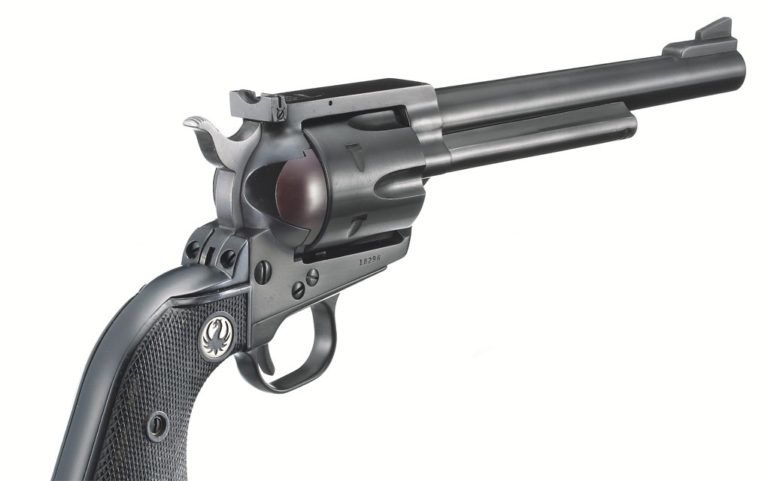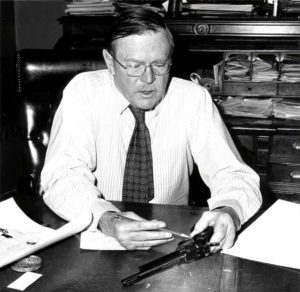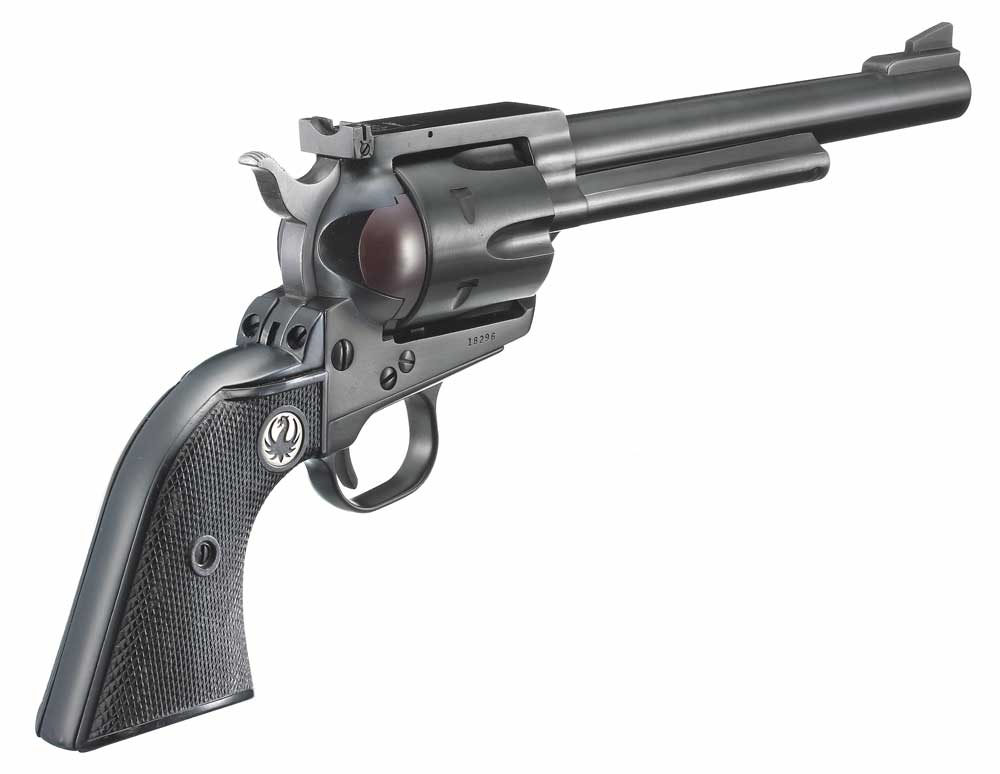
In the 1950s, Ruger introduced the venerable Blackhawk revolver, which remains both a desirable collector piece and a popular current-production gun.
What makes the Ruger Blackhawk a popular revolver, both in terms of current production and as a collector's piece?
- Introduced in 1955, the Blackhawk was Ruger's first centerfire revolver, and it's still produced more than 70 years later.
- While development of the .44 Magnum was underway, both Ruger and S&W strove to introduce the first .44 Magnum revolvers, Ruger with an updated Blackhawk and S&W with the .44 Magnum, later known as the Model 29.
- There were a number of Blackhawk variants developed, including the Super Blackhawk, Flattop Blackhawk and the New Model series, along with a number of different caliber options.
- The Flattop models tend to command the highest values on the collector's market.
In 1950 Bill Ruger’s gun company was on its way to becoming a major player in the industry, thanks to the success of his .22 Standard Pistol that had been introduced the previous year. The co-founder of Sturm, Ruger & Co. was ready to take the next step and add another product to the line. Ruger had always been a fan of single-action revolvers. He liked the simplicity and reliability of the old Colt design, along with its graceful shape and the way it felt in the hand.

Western movies were very popular in the late ’40s and early ’50s, and virtually every cast member was armed with a single-action sixgun. The Colt Single Action Army had been out of production since 1940, and the company had announced it was no longer going to be made. Timing, as they say, is everything. Bill Ruger saw that the time was right to create a new, up-to-date single-action for a waiting market. His idea was to make a rimfire six-shooter as a companion to his Standard to be known as the Single-Six.
Find Out More About Ruger Firearms
Work on the model was under way in 1951 and, by the end of 1953, Sturm, Ruger & Co. had its second handgun on the market. Like the .22 semi-auto pistol, the Single-Six was a big success and became very popular with plinkers, campers, hikers and small-game hunters.
The success of the Single-Six encouraged Bill Ruger to take the next step in the development of his line of handguns, a larger centerfire model, with the overall size about the same as the Colt. Like the Single-Six, it would be patterned after the Colt but with several changes, including an adjustable rear sight and coil springs instead of leaf springs in the action. It was decided that the new revolver would be chambered in .357 Magnum, the most versatile choice because it would also fire the .38 Special.
In 1955, Ruger’s first single-action centerfire revolver was introduced with a suggested retail price of $87.50 and was called the Blackhawk. In addition to his interest and affection for firearms, Bill Ruger was an admirer and collector of classic automobiles. One of his favorites was the Stutz Blackhawk. (Yet to come to the Ruger line was the Bearcat, named for another Stutz auto.) Barrel lengths of the Blackhawk were 4.625, 6.5 and 10 inches. Only a few hundred were made with the 10-inch barrel.

Diversifying The Legend
The Blackhawk went on to become one of the most successful Ruger firearms. It’s still being manufactured 72 years after its introduction, and, as would be expected, there have been several changes to the original design.
One of the first was the addition of a new cartridge for the Blackhawk. It was being developed by Remington and Smith & Wesson and would be called the .44 Remington Magnum. Based on a lengthened .44 Special case, it was designed for a firearm that would also use .44 Special ammo, like the relationship between the .357 Magnum and .38 Special. In 1956, Bill Ruger learned the .44 Magnum was being developed and quickly decided to chamber it in the Blackhawk, beefing up the cylinder and frame to handle the heavier recoil. Barrel lengths of 6.5, 7.5 and 10 inches were to be offered. The latter two lengths are worth a premium on the collector’s market.
There was somewhat of a race between Ruger and S&W to get the first .44 Magnum revolver to market. Depending on who you talk to or what you read, the winner could be either one. Phrases such as “went into production” or “was introduced” are not necessarily the same in the gun business, nor is an exact date when a gun is first sold in a retail setting. But in either event, by the end of 1956, both Ruger and S&W were in the .44 Magnum business, Ruger with the Blackhawk and S&W with what was then known simply as the “.44 Magnum” revolver, later called the Model 29.
Not long after the .44 Magnum Blackhawk hit the market, Ruger began to receive complaints about the six-gun’s stout recoil. The answer was the Super Blackhawk, a larger model with a heavier frame, more substantial Dragoon-style grip, non-fluted cylinder and squared trigger guard. It was introduced in 1959, with the early models sold with a mahogany carrying case, smooth walnut grips and a 7.5-inch barrel. A few hundred were made with a 6.5-inch barrel, and about 1,600 with a brass frame.
The original cylinder top strap was flat-shaped and, in 1962, was reshaped to offer more protection to the rear sight. After this change, the earlier model became known as the Flattop Blackhawk. This was in 1962 at about serial number 42,600. That same year, several new calibers were added to the original Blackhawk including the .41 Magnum, .45 Colt, .30 Carbine and convertible models with interchangeable cylinders in .357/9mm or .45 Colt/.45 ACP. Other variations to the original Blackhawk over the years included several different grip options, reshaping of the ejector rod and a brass frame for a few rare models.
The biggest change to the Blackhawk (and all Ruger single actions, including the Super Blackhawk, Single-Six and Bearcat) was the New Model series. This major change involved a transfer bar that allowed each model to have a fully loaded cylinder.
Early classic single actions were all essentially “five shooters,” and wise shooters always carried them with the hammer resting over an empty chamber. This was a safety issue to ensure the firearm would not discharge if dropped. This change occurred in 1973, and all subsequent Ruger single actions have the transfer bar operating system. With the transfer bar lockwork, the hammer is never in contact with the firing pin. Unless the trigger is pulled, the gun cannot fire. When the trigger is pulled, the transfer bar pivots to a point between the hammer and the firing pin, and when the hammer strikes the bar the energy transfers to the firing pin.
Editor's Note: This Collector's Corner column is an excerpt from the Fall 2017 issue of Gun Digest the Magazine.
Get More Ruger Info:
- Great Ruger Guns
- Ruger No. 1
- Ruger Precision Rifle
- Ruger Redhawk
- Ruger Super Redhawk
- Ruger Single Six
- Ruger 10/22
- Ruger LCR
- Ruger LCRx
- Ruger 77/22
- Ruger 77/44
- Ruger SR1911
- Ruger Hawkeye
- Ruger Mark IV
- Ruger SR-556
- Ruger LCP II
- Ruger American Magnum
- Ruger American Rifle
- Ruger Gunsite Scout Rifle
- Ruger SR-762
- Ruger Red Label
- Ruger SR40
- Ruger Single Nine
- Ruger P345

Next Step: Get your FREE Printable Target Pack
Enhance your shooting precision with our 62 MOA Targets, perfect for rifles and handguns. Crafted in collaboration with Storm Tactical for accuracy and versatility.
Subscribe to the Gun Digest email newsletter and get your downloadable target pack sent straight to your inbox. Stay updated with the latest firearms info in the industry.

![Best Concealed Carry Guns In 2025 [Field Tested] Wilson Combat EDC X9S 1](https://gundigest.com/wp-content/uploads/Wilson-Combat-EDC-X9S-1-324x160.jpg)


![Best 9mm Carbine: Affordable PCCs [Tested] Ruger Carbine Shooting](https://gundigest.com/wp-content/uploads/Ruger-Carbine-Shooting-100x70.jpg)
![Best AR-15: Top Options Available Today [Field Tested] Harrington and Richardson PSA XM177E2 feature](https://gundigest.com/wp-content/uploads/Harrington-and-Richardson-PSA-XM177E2-feature-100x70.jpg)
